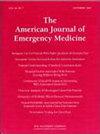Feasibility and efficacy of simulation training for joint dislocation management in residency
IF 2.7
3区 医学
Q1 EMERGENCY MEDICINE
引用次数: 0
Abstract
Background
Residents in EM training programs are required by the Accreditation Council of Graduate Medical Education (ACGME) to achieve competency in joint dislocation management. Our study group developed three large joint dislocation task trainers and evaluated their feasibility and efficacy in residency training.
Methods
During the study period, participants attempted reduction of the dislocation task trainers. Study personnel collected data from these attempts, including procedural success, time to hand placement, and time to joint reduction. Hands-on education was then provided. Learners participated a second time during the study period, and collection of data was repeated. Rates of successful joint dislocation reductions were determined and reported with exact 95 % binomial confidence intervals (95 % CI). Medians and upper and lower quartiles for time to hand placement and time to successful reduction were calculated and reported.
Results
Among first-time users, the successful reduction rates for the shoulder, hip and elbow were 63 % (19/30, 95 % CI 43–80 %), 83 % (25/30, 95 % CI 62–94 %), and 90 % (27/30, 95 % CI 73-97 %) respectively. For second-time users, successful reduction rates were 100 % (30/30, 95 % CI 88–100 %) for all joints. Among first-time participants, the median times to achieve successful shoulder, hip, and elbow reduction were 69 s (IQR 32, 92), 35 s (IQR 22, 49), and 16 s (IQR 13, 24) respectively. For second-time users, the median times to reduce these joints were 24 s (IQR 14, 40), 14 s (IQR 11, 17) and 10 s (IQR 7, 12).
Conclusion
Our data suggest that large joint dislocation management training is feasible using high-fidelity simulation task trainers. Additional study is planned to assess the potential role of this approach for improving procedural competency in the clinical realm.
住院医生关节脱位处理模拟训练的可行性和有效性
研究生医学教育认证委员会(ACGME)要求急诊培训项目的校长具备关节脱臼管理的能力。本研究小组开发了三种大型关节脱位任务训练器,并评估了其在住院医师培训中的可行性和有效性。方法在研究期间,参与者尝试用训练器减少脱位任务。研究人员从这些尝试中收集数据,包括手术成功、手部放置时间和关节复位时间。然后提供动手教育。学习者在研究期间第二次参与,并重复收集数据。成功的关节脱位复位率被确定并报告为精确的95%二项置信区间(95% CI)。计算并报告了手放置时间和成功复位时间的中位数和上、下四分位数。结果在首次使用者中,肩部、髋部和肘部的复位成功率分别为63% (19/30,95% CI 43 - 80%)、83% (25/30,95% CI 62 - 94%)和90% (27/30,95% CI 73- 97%)。对于第二次使用者,所有关节的成功复位率为100% (30/30,95% CI 88 - 100%)。在首次参与者中,成功完成肩关节、髋关节和肘关节复位的中位时间分别为69秒(IQR 32, 92)、35秒(IQR 22, 49)和16秒(IQR 13, 24)。对于第二次使用者,减少这些关节的中位时间为24 s (IQR 14,40), 14 s (IQR 11,17)和10 s (IQR 7,12)。结论采用高保真度模拟任务训练器进行大关节脱位管理训练是可行的。进一步的研究计划评估这种方法的潜在作用,以提高程序能力在临床领域。
本文章由计算机程序翻译,如有差异,请以英文原文为准。
求助全文
约1分钟内获得全文
求助全文
来源期刊
CiteScore
6.00
自引率
5.60%
发文量
730
审稿时长
42 days
期刊介绍:
A distinctive blend of practicality and scholarliness makes the American Journal of Emergency Medicine a key source for information on emergency medical care. Covering all activities concerned with emergency medicine, it is the journal to turn to for information to help increase the ability to understand, recognize and treat emergency conditions. Issues contain clinical articles, case reports, review articles, editorials, international notes, book reviews and more.

 求助内容:
求助内容: 应助结果提醒方式:
应助结果提醒方式:


